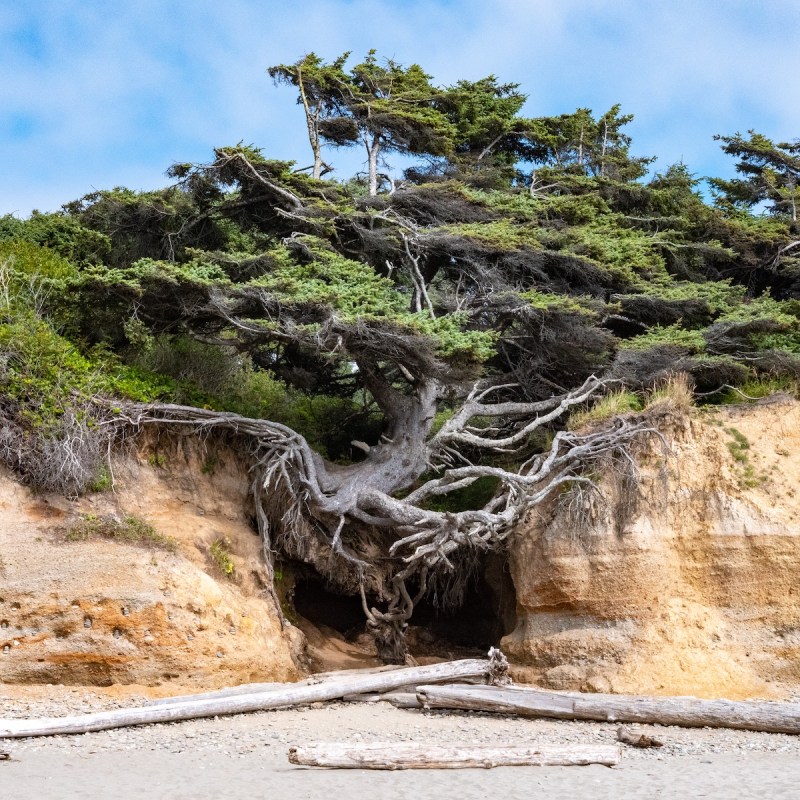
The state of Washington has a trifecta of national parks. North Cascades is near the Canadian border on Washington Highway 20. Mount Rainier is east of Seattle/Tacoma with entrances on either the west or east side of the mountain. Olympic is on the Olympic Peninsula and is the largest of the three parks.
Videos by TravelAwaits
Visiting these three parks is a great road trip. It’s about 200 miles south from North Cascades to Rainier and another 260 miles west to the Hoh Rainforest in Olympic. (I selected the Hoh Rainforest and Kalaloch areas of Olympic to focus on. These locations are on the Pacific side of the park.)
These amazing parks can be enjoyed by everyone. None of them have tour buses, trams, or attractions like Old Faithful. Before you go, it’s good to have an idea of what you can see and where you can get the best views. I picked 11 things to see and visit even if you are not a hiker or wilderness backpacker.
Pro Tip: Some roads, visitor centers, and campgrounds in all three parks are seasonal — opening in May/June and closing by October/November due to cold weather.

North Cascades National Park
1. Picnic At Diablo Lake Overlook
Stop at the Diablo Lake overlook and sit below a glacier-laden mountain while you gaze at the spectacular turquoise water. The overlook has a large parking area, many picnic tables, and trees for shade. You tower above the lake and watch kayakers far below try their hand at navigating the currents. There are restrooms and potable water.

2. Walk To The Scenic Overlook At Gorge High Dam
There is plenty of parking at this overlook. Take a paved trail that takes you to scenic overlook of Gorge High Dam on the beautiful Skagit river below. Look for the waterfall from the trail. It’s across the gorge. You may hear it before you see it! This is an easy, worthwhile trail in a tranquil setting.

3. View Hozomeen Mountain
Hozomeen is visible only from one pullout on Highway 20 and is in the far distance, nearly at the Canadian border. At the last pullout on the highway, before you exit the park on the east side, there is an information board that describes how the author Jack Kerouac wrote about his time living in the park, viewing the mountain. Hozomeen is actually a pair of twin peaks that reach 7,500 to 8,000 feet in elevation. Most people go to the mountain by hiking through the backcountry wilderness or boating up Ross Lake. From your vantage point on the highway, you can see a portion of Ross Lake below you.
Pro Tip: Because Washington Highway 20 is the only road in the park, there is no entry fee.

4. Visit Historic Newhalem
Outside the western entrance to the park, stop in the historic town of Newhalem. Tour the history of the Skagit River Hydroelectric Project that brings energy to Seattle. Historical exhibits are in the Skagit Information Center as well as around this tiny town.
Take the suspension bridge at the end of Main Street and enjoy beautiful views of the turquoise Skagit River. There is also an easy, though unpaved walk through the Trail of the Cedars. This old-growth forest is amazing but has uneven ground in some places. The beginning of the walk is packed with gravel and will give you a good view of the forest.
Fishing is a popular activity up and down the Skagit River and in the park. Be sure to have a state fishing license.
You’ll find the North Cascades Visitor Center just to the west of Newhalem.
Pro Tip: Use Burlington, Washington, at I-5 as your base camp to visit North Cascades. RV camping is available in Rockport, about halfway to the park.

Mount Rainier National Park
5. Drive To The Alpine Meadow At Sunrise Visitor Center
Mount Rainier is the iconic 14,000-foot volcano that personifies the Seattle/Tacoma region. Its presence is commanding. It is perpetually snow-covered with glaciers on all sides.
The Sunrise Visitor Center is on the eastern side of the mountain at a 7,000-foot elevation. You’ll be rewarded after an hour’s drive from the entry gate with tantalizingly close views of Rainier and the Emmons Glacier. The visitor center has ample parking and is in an alpine meadow. In summer, you’ll find the meadow bursting with wildflowers amongst the lush grasses. There’s a gift shop in the visitor center and a snack shop in the Sunrise Day Lodge, open 5 days a week.

6. View The Emmons Glacier As You Picnic
There is an amazing picnic area behind the visitor center where you can pick out a secluded table and gaze at the blue ice of Emmons Glacier. You’ll get an even better view of the glacier from a viewing area that requires a little downhill (and uphill back) walk on a solid, wide path from the parking lot. If you want to dip your toe into hiking, walk a bit of the Silver Forest trail that leads away from the viewing area and you’ll get another vantage point of the mountain. The Silver Forest trail is narrow and on unlevel ground.
Alternatively, walk from the picnic area on a very wide and level path, a bit uphill, into the meadow until you get to the turnoff for different hiking trails. At this vantage point, you can see Burroughs Mountain — a flat-topped mound that is quite distinctive.

7. Stop At Sunrise Point For Views Of Rainier And The Cascade Mountains
Stop at the large parking lot at Sunrise Point on the road to and from the Sunrise Visitor Center at 6,000 feet elevation. You can view the alpine Sunrise Lake 400 feet below. There are paved vantage points across the road from the parking lots, with picturesque vistas of the mountains in all directions that are perfect for taking photos.

8. Visit The Longmire Historic District
The Paradise Visitor Center and the Longmore Historic District are on the western side of Rainier. Longmire is the original park office built in 1916. You can visit the information center and museum of the history of the park.
Pro Tip: Stay on the western side of the park in one of two historic hotels: Paradise Inn or the National Inn in the Longmire Historic District. The sunset light, called Aspenglow, reflects on the mountain.

Olympic National Park
9. Picnic And Walk In The Hoh Rainforest
On this Pacific Ocean side of the park, you’ll find the Hoh Rainforest, the northernmost such forest in the world. There’s one word to describe the Hoh Rainforest: otherworldly. Enormously tall, old-growth trees drip moss and are covered in lichen. They rise from a forest floor carpet of giant ferns. I was sure a dinosaur would run into my campsite momentarily! This area gets over 100 inches of rainfall annually, mainly during the winter.
Take the easy, 0.8-mile Hall of Mosses walk through the rainforest at the visitor center. There is a daily ranger-led walk and talk on this relatively easy path. There are plenty of picnic tables to enjoy in the day-use area with very easy walking paths under tall trees. Or walk/drive into the campground just beyond the visitor parking lot to enjoy some huge trees and get views of the Hoh River.
Pro Tip: This is a remote location. It’s 18 miles from the Highway 101 turnoff to the visitor center. At mile 10, you’ll reach the park entrance where fees are collected or passes observed. You’re 30 miles from the nearest gas station at Forks. Potable water is available at the visitor center.

10. View The Hoh River
You’ll drive along the Hoh River on the way in. It is broad and moves quickly as it comes down 7,000 feet from the glaciers and snowpack on Mount Olympus. It expands to its banks in spring and falls back to a narrower body during the summer when the spring snowmelt tapers off. Just before and after the park entry gate, you’ll see pullouts where you can safely park. From these points, you can walk a short distance to see the river. If you would rather not walk, drive through the campground next to the visitor center and see the river from there.

11. Kalaloch Beach
There are many beautiful beach sites along the edge of the park on the Pacific Ocean on U.S. Highway 101. Many are not easy to reach and require hiking up and down. The most accessible beach is Kalaloch, about 40 miles from the Hoh Rainforest turnoff. There are cabins, a lodge, and a campground on this national park property. The Tree of Life, a bluffside tree with striking visible roots, is the most well-known point of interest on this beach. Stairs are available to go up and down, but you must watch the tide charts so you aren’t trapped on the beach with floating logs.
Pro Tip: If you can’t stay in Kalaloch, you can stop at numerous pullouts along the highway in the area to get great views of the ocean. Some have parking areas and paths that lead to the beach. These walks can be strenuous and steep.
National parks mentioned in this article:
